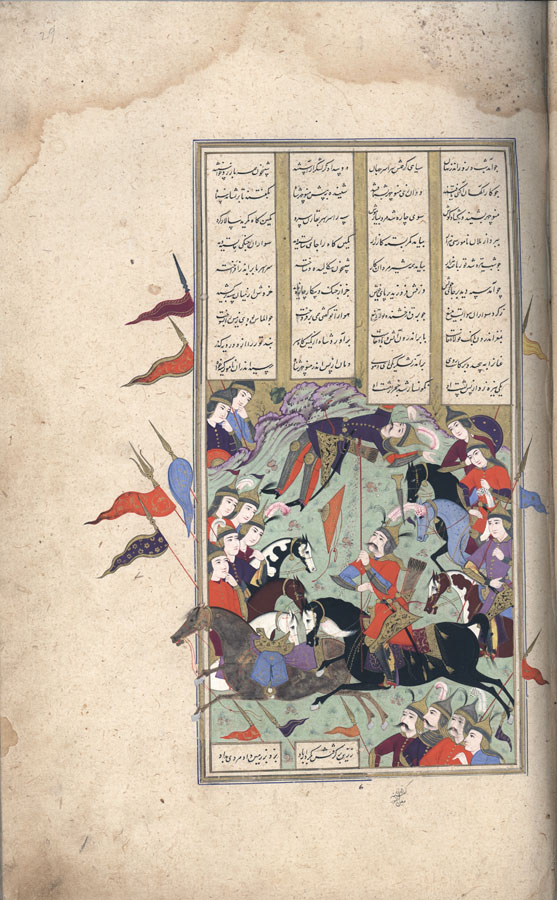Manučehr Kills Tur
The painting depicts the narrative at the juncture when Manučehr has already wounded Tur in the back, and has lifted his opponent from the saddle on the point of his lance. The disposition of combatants, Iranians on the right and Turānians on the left, has been further emphasized by Manučehr’s lance, which is held vertically on the center line of the composition. At the top of it is Tur, about to be crashed to earth. Blood vividly gushes from the wound; his shield, jarred from his grip, floats in mid-air. Clutching the controlling end of the lance is Manučehr, who by virtue of his relative isolation and large black mount stands out as the dominant personage. Alongside, but behind him in pictorial space is Tur’s gray mount, that gallops riderless to the left. A total of fourteen other figures and six additional horses are depicted, dispersed in small groups tightly compacted together so as not to visually compete with the main combatants. The heads and shoulders of four of them are visible in the lower right, the lower portion of their bodies cropped by the frame. On the extreme right, behind Manučehr in the pictorial space, are three horses and riders, disposed one behind the other in depth. Compositionally balancing this group, on the extreme left, are the heads of five other warriors tightly grouped together. Only three of their horses are visible. The two remaining warriors peer from behind a ridge in the upper left with their finger to the lips in a sign of astonishment. The artist has made no attempt to distinguish between Iranian and Turānian uniforms, for all the warriors wear pointed steel helmets with ear guards, leather arm and leg protectors, and dress of identical style. The setting is, as usual for combat scenes, a sloping non-descript hillside that rises to a craggy crest near the top.
There are four columns of text above the painting. Two columns are comprised of ten lines, the other two of only nine lines each. A single line of text appears at the bottom left and evens off the total number of text lines on the page. A ruled frame encloses illustration and text except for three standards on the right side, and five standards and the head of a horse on the left side, which violate the frame and protrude into the side margins. These violations of the frame bestow an active quality to the painting which it otherwise would not have. The painting is signed near the center of the lower margin, in miniscule characters in Moʿin’s hand: raqam zad kamina moʿin-e moṣavver. No date is indicated.
Painting references:
Welch, AK4_1978, p.89, Ms.22, folio 29r (not illustrated).
Text references:
Warner, I, pp.220-21; Mohl, I, pp.145-47; Levy, p.34.
Robert Eng
Last Updated: May 19, 2011 | Originally published: May 19, 2011
